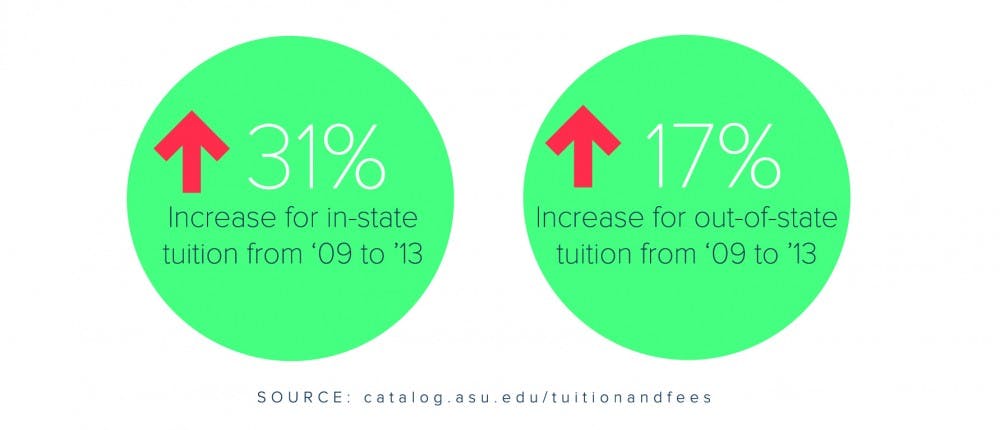 (Graphic by Karen Loschiavo.)
(Graphic by Karen Loschiavo.)
ASU tuition rose 3 percent this year after the Arizona Board of Regents approved an increase in April. The raise is one of several over the past few years that resulted from a decrease in state funding for universities, said Morgan Olsen, ASUexecutive vice president, treasurer and chief financial officer.
The raise has left some students, even those with scholarships, with no choice but to take out loans or sacrifice spending in other areas.
Tensions are high among these students, who are left to wonder where their tuition dollars are going and why the costs are increasing.
Alex Medawar, a biomedical engineering senior entering his ninth semester, had to take out his first loan last year to cover his tuition costs, even though he had a four-year scholarship.
"My only expense as a freshman was $1,000: $500 for books and $500 for parking," he said.
Those costs have risen for him significantly, so much so that he had to work full time this past summer for the first time since starting college. He also stopped buying books for his classes.
The higher costs have even had an impact on students with full-ride scholarships.
English senior Tom Kushibab has seen less of a return from his scholarship.
"I get less money back to pay for parking, books and general cost of living stuff," he said.
Kushibab said he was concerned that his tuition was covering exorbitant salary increases for administrators.
"I remember reading about pay raises for administrators and deans," Kushibab said. "I wondered if my tuition was going there."
Olsen attributes the raise in the University's sticker price to a loss of $200 million in funding from the state of Arizona. He said a larger portion of tuition covers costs of classroom instruction.
"The major uses of tuition are to support the instructional process and academic support," Olsen said. "Libraries for example, or student services."
According to the University, 41 percent of ASU's budget goes to faculty salaries.
 (Graphic by Karen Loschiavo)
(Graphic by Karen Loschiavo)
Only a small part of cumulative tuition funds go to the construction of new facilities, Olsen said.
More than $10 million of the funding for McCord Hall, a new building in the W. P. Carey School of Business, came from gifts, he said.
The $110 million project to build new athletic facilities on all four campuses came from money that will be repaid by students through a Student Service Facility Fee, Olsen said.
The Undergraduate Student Government proposed the plan, and full-time students pay a fee of $75 per semester.
Although costs are rising for students, ASU had a scholarship allowance of $195 million for fiscal year 2012 and set aside 15 percent of the budget for fiscal year 2013 for need- and merit-based scholarships.
Olsen wants to make sure students realize that ASU is still an affordable option compared to other comparable universities.
"The cost is significantly lower than the average across the country, which means that students are getting a lot for their money," he said.
Olsen said students should continue to invest in their education.
"Your education that will always be with you," Olsen said.
Reach the reporter at losch.karen@gmail.com or follow her on Twitter @karenlosch




